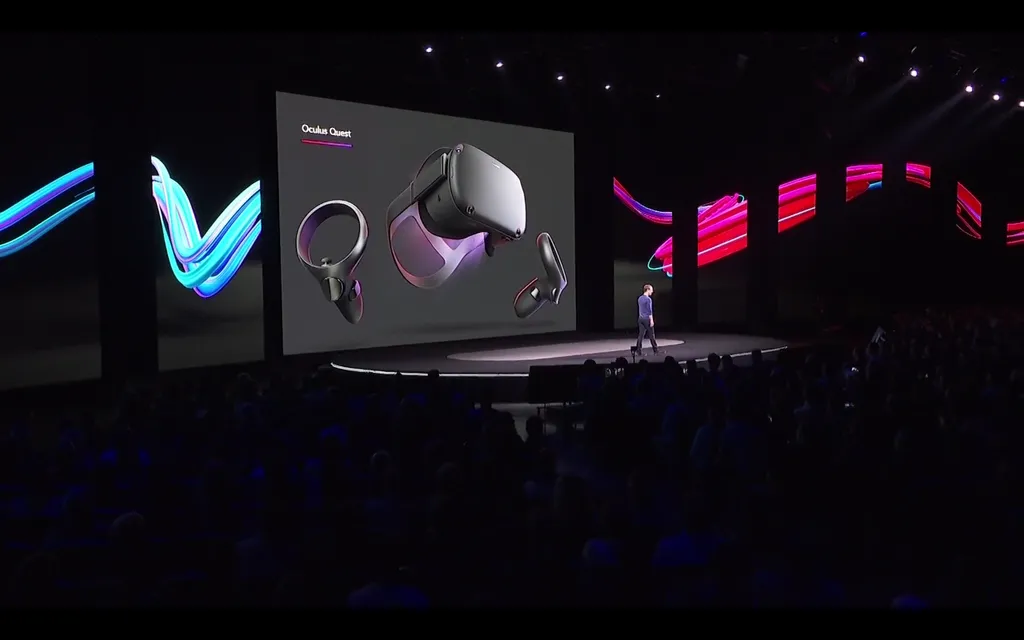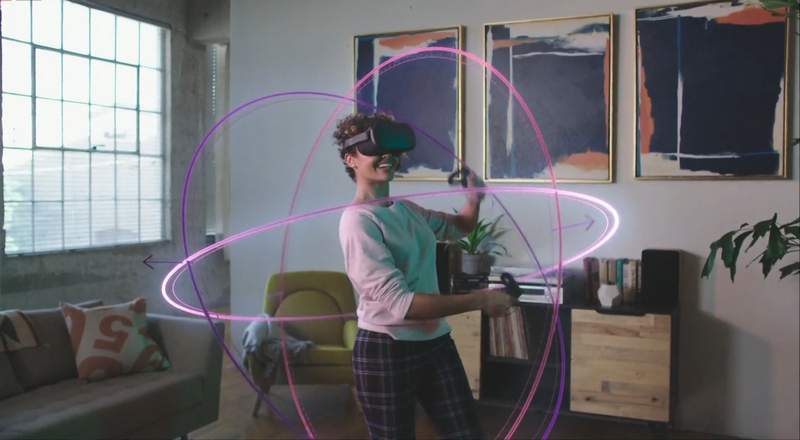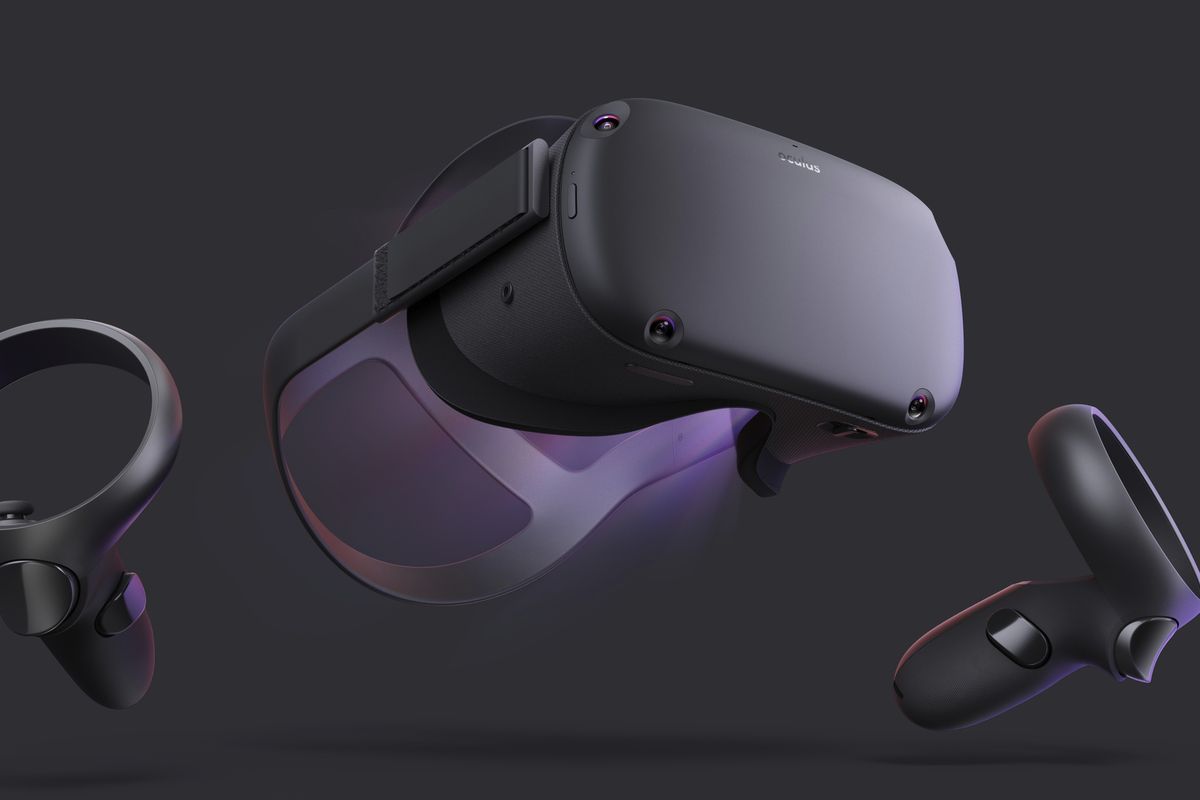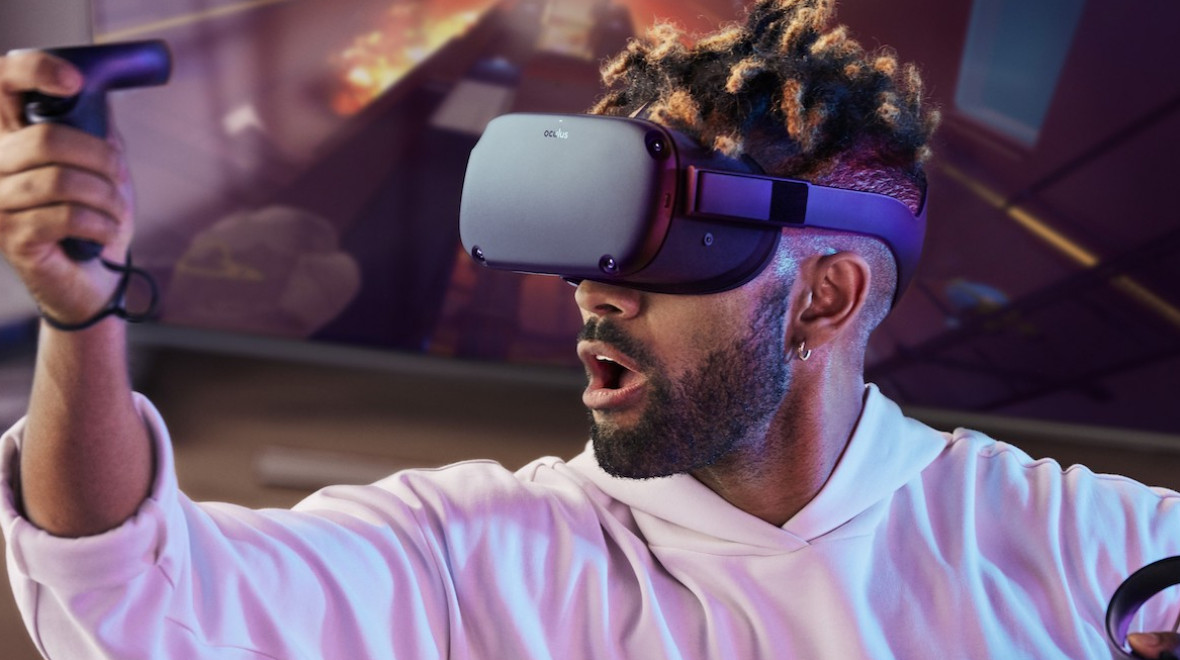Oculus used its Connect 5 conference this year to properly reveal its highly-anticipated standalone VR headset with six degrees of freedom (6DOF) inside-out tracking, named Oculus Quest. With Rift-like tracking in a headset that doesn’t need to be tethered to an expensive PC, Quest may represent VR’s best chance yet at catching on with the mainstream. But what do we actually know about it?
Based on what we learned at OC5 and beyond, we’ve compiled a handy guide for the newest member to the Oculus family.
Quick Links:
Tracking Is “Indoor Only” But Still “Exceeds” Current Room Scale
Active Cooling Internal Fan
Launch Lineup Discussion, Cross-Play and Cross-Buy with Rift
Q&A Livestream
Oculus Quest Hands-On Impressions
Impressive Arena-Scale Tech Demo with Video
Superhot VR on Quest Hands-On
Oculus Discusses Controller Tracking Limitations
List of Developers Working on Quest Content
Snapdragon 835 Details
Up Close Photos of Quest Touch Controllers
Original Announcement with Price and Release Date
Over 50 Launch Titles Coming
OC5 Keynote Recap
PC VR Mode Considered
It’s An All-New Headset
There’s been a little confusion as to if Quest is a new version of Oculus Go or the sequel to the Oculus Rift. In short, it’s neither. Yes, Quest is standalone like Go and has features similar to Rift, but it’s got its own ecosystem that falls directly in the middle of those two devices. It won’t mirror Gear VR’s content library like Go does and any Oculus Rift games that appear on it will be direct ports just like when, say, a PS4 game gets ported to Xbox One. You won’t need any other Oculus hardware to get into Quest, nor will you need a PC.
Tracking Is Similar To Rift, But Not Identical
Oculus Quest’s big draw has always been its 6DOF tracking, which puts it a step above the 3DOF Go headset. Whereas Go allows you to rotate and tilt your head to look around in VR, Quest is closer to Rift in that you can move your head forward, backward, left, right, up and down and have all of those movements replicated within a virtual world. But it’s not identical to Rift, either; the crucial difference is that Quest uses a new inside-out tracking system called Oculus Insight.
Rather than placing external sensors around your room to track you like with the Rift, Quest has four wide-angle sensors fitted to the corners of its front faceplate. These read the room around you to locate your position within it, and you’ll also be able to set up a Guardian system to avoid obstacles like chairs. This allows Quest’s tracking to go ‘Beyond Roomscale’ and even store tracking setups for multiple rooms, though it may also mean tracking can’t keep up if you put your controllers behind you. We’ll need to do extensive testing with the limits of this system.
Its Controllers Are Similar To Touch, But Not Identical
Another big leap for Quest — and something that many other 6DOF standalone headsets don’t have — is two fully tracked hand controllers, which are just new versions of the Touch controllers that come with the Rift. They have the same amount of buttons including analog sticks, triggers, grip buttons and face buttons and will accurately replicate your movements so long as the sensors can see them. To that end, Oculus has rearranged the tracking ring seen on the original Touch to now extend over the top of the controllers rather than under it, which could give them more visibility.
It’s More Powerful Than A Go, But Not As Powerful As Rift
As we learned after the keynote, Quest is powered by Qualcomm’s Snapdragon 835 mobile processor. That’s not quite top of the line; it was used in Samsung’s 2017 Galaxy S8 smartphone, for example, but replaced with the next generation 845 in this year’s S9. It is, however, a generation beyond the Snapdragon 821 that’s fitted inside Oculus Go. It’s important to note that Quest’s dedicated hardware will mean all of that horsepower can be devoted to VR, though, unlike on a phone.
You can look forward to some amazing fidelity from Quest games, then, but don’t expect the latest and greatest Rift games to be able to run on the device. Some of Rift’s most demanding games are already taking full advantage of graphics cards far more powerful than what you’ll find in Quest, but it will still be good enough for a lot of developers to be able to scale down and port their experiences with excellent results.
It’s Going To Have Lots Of Rift Ports, But Also New Games
To that end, Oculus is preparing a lot of ports of Rift games for Quest. At Connect 5 yesterday we learned that popular titles like Moss, The Climb and Robo Recall will be making their way to the device. On display at the event, meanwhile, are new versions of time-bending shooter, Superhot VR, and Oculus’ own multiplayer shootout showcase, Dead and Buried.
There will be new games too, of course. On display at Connect is Face Your Fears 2, the sequel to Turtle Rock Studios’ super-popular VR terror showcase. There’s also a new multiplayer tennis game being shown on a properly-scaled tennis court. Finally, Oculus revealed a list of developers that are “experimenting” with Quest, which included some of the biggest names in VR like Ready at Dawn, Insomniac Games, and High Voltage Software. In fact, it’s promising over 50 games will be ready for launch next year. There’s also a brand new Star Wars VR series, Vader Immortal, set to debut on the platform.
Speaking with Oculus Product Managers we also confirmed that several of the “top” non-gaming apps from Go will make their way to Quest as well.
It’s Display And Audio Match Go, Internally Different
Oculus Go might be cheaper than the Rift, but the two years of extra development time brought about some important improvements that Quest will be using too. For starters, it’s got a slightly better resolution of 1600 x 1440 per eye display resolution, which is actually better than what’s on Rift right now, though it still hasn’t completely done away with the dreaded screen-door effect (which describes the effect of seeing gaps between pixels).
On the audio front, Quest also utilizes the brilliant in-ear speaker system first shown in Go. Whereas Rift has headphones you wear, Quest will directly emit the sounds of the virtual world right into your ears, giving you a more immersive experience but also letting you hear the outside world with ease too.
Additionally, we’ve confirmed with Oculus Product Managers that the Quest will have internal, active cooling via a built-in fan, rather than heat dissipation like the Go’s metal front plate. We also know the Quest will get casting features similar to Go.
It Costs The Same As A Rift, But Doesn’t Need The Expensive PC
Now for the important bit. Oculus Quest costs exactly the same as the Oculus Rift: $399 (which is double the price of the $199 Go). Consider, though, that Quest is an all-in-one system, meaning everything you need to jump into VR is embedded inside the headset already. The Rift, meanwhile, still requires an expensive PC that it must be tethered to at all times in order to work. As such, the all-in price of a Quest is drastically lower than that of the Rift.
It’s Coming Early In 2019
Finally, Oculus confirmed that Quest is coming sometime early this year for $399. There’s no official date, though we’ve heard the company is aiming for a Q1 launch. That said, we wouldn’t be surprised if it slipped back to Q2, perhaps launching around Facebook’s F8 conference much like Go did in May of this year.
Editor’s Note: This post will be regularly updated by various members of the UploadVR team.




























